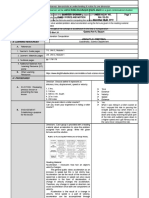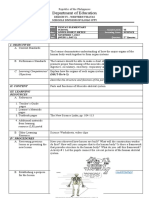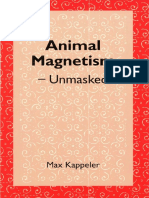Heart Dissection Lab Report Guide (GALO)
Heart Dissection Lab Report Guide (GALO)
Uploaded by
galo09landivar0902Copyright:
Available Formats
Heart Dissection Lab Report Guide (GALO)
Heart Dissection Lab Report Guide (GALO)
Uploaded by
galo09landivar0902Original Title
Copyright
Available Formats
Share this document
Did you find this document useful?
Is this content inappropriate?
Copyright:
Available Formats
Heart Dissection Lab Report Guide (GALO)
Heart Dissection Lab Report Guide (GALO)
Uploaded by
galo09landivar0902Copyright:
Available Formats
Year 10 Pre-Diploma Biology
Heart Dissection
Introduction
This lab practical allows you to identify and compare the size, shape and tissue type of the
major chambers and vessels of the heart. The goal of the lab is not just to observe anatomy,
but to associate structure with function. The heart is a pump for blood that comes
into the right atrium, goes out to the lungs through the right ventricle, returns through the
left atrium, and leaves again through the left ventricle - a double circulation. Each chamber
is separated by valves that prevent the backflow of blood. Try and figure out where the
various components are, how each works, especially how the shape, composition, and even
texture of each part contribute to its function.
Preliminary Questions
! "hat is the heart#s surface like$ "hat function do you think this serves$
The heart was very slippery and wet, so the heart can move in the rib cage, this helps to
reduce friction.
%! &ow does the heart muscle itself receive oxygen for respiration$
The heart muscle receives oxygen by the coronary arteries.
Observation: External AnatomyDO NO !" AN#$IN% #E&
As you follow the instructions and find each structure, label a pin and stick the pin in the
structure. I must see all 10 structures before you may continue to the internal structures.
. 'dentify the right and left sides of the heart. (ook closely and on one side you will see a
diagonal line of blood vessels that divide the heart. The half that includes all of the apex
)pointed end! of the heart is the left side. *onfirm this by s+ueezing each half of the heart.
The left half will feel much firmer and more muscular than the right side.
%. Turn the heart so that the right side is on your right, as if it were in your body. ,ind the
large opening at the top of the heart next to the right auricle )flap of darker tissue on top of
the heart!. This is the opening to the su'erior vena cava, which brings blood from the
top half of the body )arms and head! to the ri(ht atrium) *arefully stick a glass rod down
this vessel. -ou should feel it open into the right atrium. . little down and to the left of the
Year 10 2014-2015 Pre-Diploma Biology Unit 1: CVD, Heart Dissection !i"e
*aterials
/issection kit - scissors, scalpel, forceps, etc
/rawing pencils and0or /igital *amera 1ubber0latex gloves
/issection guide and results table 2ig or sheep &eart
/iagram of heart /issection board
/issection pins 3lass rod
superior vena cava there is another blood vessel opening. This is the inferior vena cava+
which also leads to the right atrium, bringing blood from the lower tissues )legs and
abdomen!. -ou can also see another blood vessel next to the left auricle. This is a
'ulmonary vein that brings blood from the lungs into the left atrium.
4. 5ticking straight up from the centre of the heart is the most muscular blood vessel you
will see. This is the aorta, which takes oxygenated blood from the left ventricle to the
rest of the body )the ventricles are the lower chambers of the heart!. The aorta branches
into more than one artery right after it leaves the heart, so it may have more than one
opening on your heart specimen. (ook carefully at the openings and you should be able to
see that they are connected to each other.
6. 7ehind and to the left of the aorta there is another large vessel. This is the 'ulmonary
artery which takes blood from the ri(ht ventricle to the lungs.
Draw simple, coloured views of the front (ventral) and a back (dorsal) eternal of the
heart.
8entral 8iew /orsal 8iew
Dissection: Internal Anatomy
.orta
2ulmonary artery
The two vena cava go into
the right atrium on the
other )dorsal! side
The pulmonary vein goes
into the left atrium on the
dorsal side.
*oronary artery and vein
"hen you need to see
inside the right ventricle,
cut here.
"hen you want to open
the left ventricle cut here.
Year 10 2014-2015 Pre-Diploma Biology Unit 1: CVD, Heart Dissection !i"e
. 'nsert your dissecting scissors or scalpel into the su'erior vena cava and make an
incision down through the wall of the ri(ht atrium and ri(ht ventricle. 2ull the two
sides apart and look for three flaps of membrane. These membranes form the tricus'id
valve between the right atrium and the right ventricle. The membranes are connected to
flaps of muscle called the papillary muscles by tendons called the chordae tendinae or
9heartstrings.9 This valve allows blood to enter the ventricle from the atrium, but prevents
backflow from the ventricle into the atrium.
!ake observations and measurements of as many structures as you can, fillin" in your
results table.
%. 'nsert a glass rod into the 'ulmonary artery and see it come through to the right
ventricle. :ake an incision down through this artery and look inside it for three small
membranous pockets. These form the 'ulmonary semi,lunar valves which prevent
blood from flowing back into the right ventricle.
4. 'nsert your dissecting scissors or scalpel into the left auricle at the base of the aorta and
make an incision down through the wall of the left atrium and ventricle, as shown by
the dotted line in the external heart picture. (ocate the mitral valve )or bicus'id valve!
between the left atrium and ventricle. This will have two flaps of membrane connected to
papillary muscles by tendons.
!ake observations and measurements of as many structures as you can, fillin" in your
results table.
6. 'nsert a glass rod into the aorta and observe where it connects to the left ventricle. :ake
an incision up through the aorta and examine the inside carefully for three small
membranous pockets. These form the aortic semi,lunar valve which prevents blood
from flowing back into the left ventricle.
At this point make sure your chart is complete with measurements and observations.
Also, make sure to draw or photo"raph each view so you can include ima"es in the lab
report showin" the structures in the table.
Year 10 2014-2015 Pre-Diploma Biology Unit 1: CVD, Heart Dissection !i"e
'nclude all other drawings of the internal heart structures here, stating from which side the
heart is being seen and labelling all identified structures.
Year 10 2014-2015 Pre-Diploma Biology Unit 1: CVD, Heart Dissection !i"e
$eart Dissection -esults able
,ill out as much of the table below as you can. 5ome boxes may not be relevant.
;bservations should include colour, texture, shape, and anything else interesting to you.
.tructure Diameter
/mm0
1all
hic2ness
/mm0
Observations
8ena *ava
6
Takes the blood from the body to the heart. 't<s
not muscular but it<s very wide. Thick walls,
thin diameter.
1ight
.trium
*ollect blood, not muscular
(arge
)Tricuspid!
valve
"hen the ventricles contract their job is to
make the blood don<t go back to the right
atrium.
1ight
8entricle
2umping blood, very muscular
5emi-lunar
valves
:akes the blood don<t flow back.
2ulmonary
.rtery
2ulmonary
8ein
(eft
.trium
*ollect blood, not muscular.
(arge
)7icuspid!
valve
"hen the ventricles contract their job is to
make the don<t blood go back to the left atrium.
(eft
8entricle
2ump blood, very muscular.
5emi-lunar
valves
:akes the blood don<t flow back.
.orta
=
4
*arries the blood from heart to the body, 't<s
muscular. The veins are floppy.
*oronary
.rtery and
8ein
Year 10 2014-2015 Pre-Diploma Biology Unit 1: CVD, Heart Dissection !i"e
$eart Dissection 3ab -e'ort
-our lab report should consist of
. . brief Introduction to what you did and what the purpose of the lab was. "hat
was the +uestion you were trying to answer, or what were the goals of the lab$ 7e
sure to specify the animal from which your heart came.
%. . -esults section that includes text and drawings0photos of the steps of the
dissection. 'n the photos, label the structures of interest. Each drawing0photo must
have a caption. .lso include in this section your completed tables of measurements
and observations.
4. . Discussion section in which you select one major anatomical feature of the
heart, e."., the tricuspid valve )valve! or the left ventricle )chamber! or the aorta
)vessel!, and discuss how its function is related to its structure. ,eatures you might
include in this description are the shape, the composition and mechanical
properties of the tissue, and the texture of any surfaces involved. #rovide evidence
from your observations, preferably numerical, for everythin" you claim.
ASSESSMENT
;7>E*T'8E E? E@2E1':EAT.( 'A8E5T'3.T';A .A/ T&E 5*'EAT','* 21;*E55
Year 10 2014-2015 Pre-Diploma Biology Unit 1: CVD, Heart Dissection !i"e
You might also like
- Muscular SystemDocument5 pagesMuscular SystemBNo ratings yet
- Lesson PlanDocument4 pagesLesson Planapi-289848178No ratings yet
- Moon Surface Lesson PlanDocument5 pagesMoon Surface Lesson Planapi-382263458No ratings yet
- The Microscope PowerpointDocument26 pagesThe Microscope Powerpointapi-250530867No ratings yet
- TGP Luzon SRP - PDF Nov 27Document14 pagesTGP Luzon SRP - PDF Nov 27Hatingmewont Keepyoupretty100% (1)
- Chicken Heart DissectionDocument2 pagesChicken Heart DissectionSebastian Villegas100% (1)
- 8-1-11 - Pig Heart Dissection - LessonDocument8 pages8-1-11 - Pig Heart Dissection - LessonShing Mae MarieNo ratings yet
- Muscular SystemDocument11 pagesMuscular SystemGerarld Agbon100% (1)
- DLP - SCIENCE Q3 WEEK 2 Day 2Document2 pagesDLP - SCIENCE Q3 WEEK 2 Day 2NIEVES FIGUEROA100% (1)
- DLP in Angiosperm Monocot and Dicot FINALDocument7 pagesDLP in Angiosperm Monocot and Dicot FINALDiane PamanNo ratings yet
- Galaxy WorksheetDocument2 pagesGalaxy WorksheetchristalNo ratings yet
- Lesson Plan Circulatory SystemDocument6 pagesLesson Plan Circulatory Systemapi-315857509No ratings yet
- Evaporation Condensation and Melting 1Document6 pagesEvaporation Condensation and Melting 1api-300813801No ratings yet
- Balanced and Unbalanced Forces Lesson Plan GGDocument3 pagesBalanced and Unbalanced Forces Lesson Plan GGSaima Usman - 41700/TCHR/MGBNo ratings yet
- Lovely LungsDocument6 pagesLovely Lungsapi-285970439No ratings yet
- LP Respiratory Act Bottled BalloonsDocument4 pagesLP Respiratory Act Bottled BalloonsRm Dela Serna SerniculaNo ratings yet
- Grade 6 Science - Space - Lesson Plan PDFDocument4 pagesGrade 6 Science - Space - Lesson Plan PDFEric Bois50% (2)
- Skeletal System DemonstrationDocument4 pagesSkeletal System Demonstrationdiana espanolNo ratings yet
- VariablesDocument3 pagesVariablesKlein Marrion Delino100% (1)
- Lesson Plan ScienceDocument3 pagesLesson Plan ScienceHaroldo KoNo ratings yet
- Gr-6 Wk6-Sci Pure Substances and MixturesDocument64 pagesGr-6 Wk6-Sci Pure Substances and MixturesammarashahzadNo ratings yet
- Year 11 General Human Biology - Lesson 2Document4 pagesYear 11 General Human Biology - Lesson 2api-345120999No ratings yet
- Detailed Lesson in BIOLOGYDocument3 pagesDetailed Lesson in BIOLOGYJamie anne Hernandez0% (1)
- Lesson PlanDocument3 pagesLesson PlanSumair Khan100% (1)
- Science Vi-Quarter 2 Module (Week 1-2 Circulatory System)Document12 pagesScience Vi-Quarter 2 Module (Week 1-2 Circulatory System)Denver TamayoNo ratings yet
- Circulatory SystemDocument18 pagesCirculatory SystemcatherinerenanteNo ratings yet
- First Quarterly Exam in Science 9Document21 pagesFirst Quarterly Exam in Science 9katherine corveraNo ratings yet
- Lesson Plan Grade 6 Leaves January 2023Document3 pagesLesson Plan Grade 6 Leaves January 2023SujathaNo ratings yet
- A Semi-Detailed Lesson Plan IN Grade 7 SCIENCE: Prepared byDocument20 pagesA Semi-Detailed Lesson Plan IN Grade 7 SCIENCE: Prepared byM-j DimaporoNo ratings yet
- Light Waves ActivityDocument2 pagesLight Waves ActivityGeorgette MatinNo ratings yet
- Microteaching TemplateDocument2 pagesMicroteaching Templateapi-401692364No ratings yet
- I. Objectives:: A Semi-Detailed Lesson Plan in General Biology-IiDocument19 pagesI. Objectives:: A Semi-Detailed Lesson Plan in General Biology-IiMhimi ViduyaNo ratings yet
- Energy TransformationDocument4 pagesEnergy TransformationJerome OcampoNo ratings yet
- Lesson PlanDocument3 pagesLesson PlanNorhayati OthmanNo ratings yet
- Seton Hill University Lesson Plan Template: Name Subject Grade Level Date/DurationDocument4 pagesSeton Hill University Lesson Plan Template: Name Subject Grade Level Date/Durationapi-299952808No ratings yet
- Detailed Lesson Plan in Science VDocument2 pagesDetailed Lesson Plan in Science VJosefina EduardoNo ratings yet
- Science 5 RevisedDocument14 pagesScience 5 RevisedJen Perven JaconesNo ratings yet
- Lesson Plan ScienceDocument4 pagesLesson Plan ScienceRa IyaNo ratings yet
- .Lesson Plan DemoDocument8 pages.Lesson Plan DemoNelita Gumata RontaleNo ratings yet
- Inherited Traits and Learning BehavioursDocument3 pagesInherited Traits and Learning BehavioursSabha HamadNo ratings yet
- Lesson Plan 1 For ScienceDocument7 pagesLesson Plan 1 For Scienceapi-264538719100% (1)
- Lesson Plan of Bones and Muscles Produce MovementDocument4 pagesLesson Plan of Bones and Muscles Produce MovementAliza Khan - 86422/TCHR/BGKG-4No ratings yet
- Science Lesson Plan: Rubrics On Assessing The Performance of Group ActivityDocument1 pageScience Lesson Plan: Rubrics On Assessing The Performance of Group ActivityRowena Sta MariaNo ratings yet
- G7 Science Q1 - Week 1-Scientific InvestagationDocument76 pagesG7 Science Q1 - Week 1-Scientific InvestagationJessa-Bhel Almuete100% (1)
- Lesson Plan: Name of The Teacher: Hrishik RoyDocument6 pagesLesson Plan: Name of The Teacher: Hrishik RoyHRISHIK ROYNo ratings yet
- Investigating Mixtures (Solution, Suspension and Colloid) : Self-Learning ModuleDocument13 pagesInvestigating Mixtures (Solution, Suspension and Colloid) : Self-Learning ModuleMica BernabeNo ratings yet
- Exit Ticket #100 Rotation RevolutionDocument1 pageExit Ticket #100 Rotation RevolutionairdogfatNo ratings yet
- Lab Activity (Dissection of Pigs Heart)Document3 pagesLab Activity (Dissection of Pigs Heart)Emily Dueñas SingbencoNo ratings yet
- Mechanical EnergyDocument44 pagesMechanical Energyrichele rectoNo ratings yet
- Science7 Q1 W1 D2Document2 pagesScience7 Q1 W1 D2Kevin ArnaizNo ratings yet
- Performance Task Solar SystemDocument1 pagePerformance Task Solar SystemSheryll Grace BanagaNo ratings yet
- Skeletal System WorksheetDocument4 pagesSkeletal System Worksheetjezhari talbotNo ratings yet
- Science - Week 1 - FrictionDocument43 pagesScience - Week 1 - FrictionMarlene Tagavilla-Felipe DiculenNo ratings yet
- Holt MCD Earth Science Chapter 6 PDFDocument32 pagesHolt MCD Earth Science Chapter 6 PDFAbegail GabineNo ratings yet
- Lesson Plan SCIENCE 6 (WEEK 1, DAY 1)Document3 pagesLesson Plan SCIENCE 6 (WEEK 1, DAY 1)Angel rose reyes100% (1)
- Lars Vanheuverzwyn - #6 - SEA-FLOOR SPREADING WORKSHEETDocument9 pagesLars Vanheuverzwyn - #6 - SEA-FLOOR SPREADING WORKSHEETLars vanheuverzwyn100% (1)
- Curriculum Map in Science 7Document12 pagesCurriculum Map in Science 7Yvette Marie Yaneza Nicolas100% (1)
- SMP Negeri 1 Padang: A. Identities School Grade / Semester SubjectDocument6 pagesSMP Negeri 1 Padang: A. Identities School Grade / Semester SubjectPutri Citra DewiNo ratings yet
- Heart Dissection Lab Report Guide2Document7 pagesHeart Dissection Lab Report Guide2Dylan FernandezNo ratings yet
- Heart Dissection Lab Report GuideDocument6 pagesHeart Dissection Lab Report Guideelorenzana0511100% (1)
- Heart Dissection, Lab Report GuideDocument5 pagesHeart Dissection, Lab Report GuideJohn OsborneNo ratings yet
- Diatetes QuestionsDocument11 pagesDiatetes Questionsgalo09landivar0902No ratings yet
- Blood - All About Blood!: An Immune System Disorder That Increases White Blood Cell Production. TuberculosisDocument2 pagesBlood - All About Blood!: An Immune System Disorder That Increases White Blood Cell Production. Tuberculosisgalo09landivar0902No ratings yet
- Colouring Rectangles: 0/4 in 1 WayDocument4 pagesColouring Rectangles: 0/4 in 1 Waygalo09landivar0902No ratings yet
- Obvious Differences Between Males and Females Is That Males Can T Get Breast CancerDocument1 pageObvious Differences Between Males and Females Is That Males Can T Get Breast Cancergalo09landivar0902No ratings yet
- Death Rates Per 1000 of The Population Per Year by Age Group and Sex, in The Uk, Year 2003Document1 pageDeath Rates Per 1000 of The Population Per Year by Age Group and Sex, in The Uk, Year 2003galo09landivar0902No ratings yet
- AU 2017 Hip, Knee & Shoulder Arthroplasty PDFDocument380 pagesAU 2017 Hip, Knee & Shoulder Arthroplasty PDFbá anh ngôNo ratings yet
- Chapter 1 Final Na BeshDocument26 pagesChapter 1 Final Na BeshTristan Tabago ConsolacionNo ratings yet
- Laporan Obat Fast, Slow Dan Death Moving Logistik FarmasiDocument5 pagesLaporan Obat Fast, Slow Dan Death Moving Logistik FarmasiPenunjang Medis Rs PMCNo ratings yet
- TB in ChildrenDocument7 pagesTB in ChildrenPororo KewrenNo ratings yet
- Center of Excellence For Placenta AccretaDocument8 pagesCenter of Excellence For Placenta AccretapolygoneNo ratings yet
- Recall 20-21 JunyDocument131 pagesRecall 20-21 JunyNicole VinnikNo ratings yet
- Resume-Vandalyn Collins Mcgrue Msn4Document7 pagesResume-Vandalyn Collins Mcgrue Msn4Anonymous UEQPru0aNo ratings yet
- Cellular Injury and Cell DeathDocument15 pagesCellular Injury and Cell DeathAlex PinhasovNo ratings yet
- Pharma List-1Document2 pagesPharma List-1mazash890No ratings yet
- Animal Magnetism PDFDocument206 pagesAnimal Magnetism PDFleustaquios100% (4)
- Historical Perspective of Intestinal Anastomosis in Veterinary SurgeryDocument9 pagesHistorical Perspective of Intestinal Anastomosis in Veterinary Surgerytaner_soysurenNo ratings yet
- Cardiac and Pulmonary Pre Block Anatomy Quiz QuestionsDocument12 pagesCardiac and Pulmonary Pre Block Anatomy Quiz Questionstlecesne100% (1)
- 12 Filler PointsDocument15 pages12 Filler PointsSripada Lk Kingjorn100% (1)
- Urinary System-1Document48 pagesUrinary System-1Muhammad SajjadNo ratings yet
- Varicocele PresentasiDocument22 pagesVaricocele PresentasiRini Oyien WulandariNo ratings yet
- PK PD en Critical IllnessDocument27 pagesPK PD en Critical IllnessDaniela BolivarNo ratings yet
- Case Study Mims KottakalDocument12 pagesCase Study Mims Kottakalsidharth benoiNo ratings yet
- Dr. Peter Duesberg's PaperDocument22 pagesDr. Peter Duesberg's PaperDainmeyen BrownNo ratings yet
- Lipid-Based Dosage Forms - An Emerging Platform For Drug Delivery-REVIEW-GOODDocument11 pagesLipid-Based Dosage Forms - An Emerging Platform For Drug Delivery-REVIEW-GOODraju1559405No ratings yet
- Nicotine DeclassifiedDocument60 pagesNicotine DeclassifiedPwnie100% (1)
- PC 4 NursingcareplanDocument2 pagesPC 4 Nursingcareplanapi-316769247No ratings yet
- I LuxDocument24 pagesI LuxNirav M. BhavsarNo ratings yet
- Respiratory Physiology & NeurobiologyDocument8 pagesRespiratory Physiology & NeurobiologyAngie TarazonaNo ratings yet
- Finaaaal PochaDocument20 pagesFinaaaal PochaToni Ann MurallaNo ratings yet
- Liposome Drug Delivery SystemDocument28 pagesLiposome Drug Delivery SystemNelsi Fitri HayatyNo ratings yet
- 55421-Gagal JantungDocument21 pages55421-Gagal JantungAngie CouthalooNo ratings yet
- Quality of Death and Dying 2021Document11 pagesQuality of Death and Dying 2021SNo ratings yet
- Goel - 1994 - Plate and Screw Fixation For Atlanto-Axial SubluxationDocument7 pagesGoel - 1994 - Plate and Screw Fixation For Atlanto-Axial SubluxationOhana S.No ratings yet
- Haccp Standards (Dutch Haccp) : Ceres Certifications, InternationalDocument20 pagesHaccp Standards (Dutch Haccp) : Ceres Certifications, InternationalMukesh RaikwarNo ratings yet






























































































